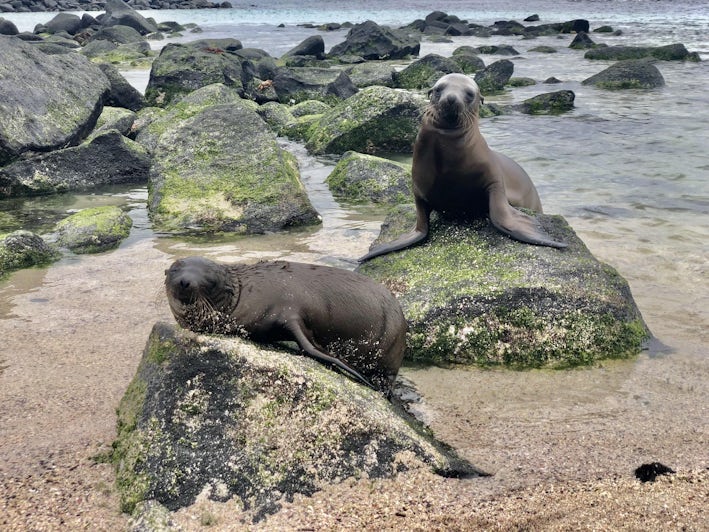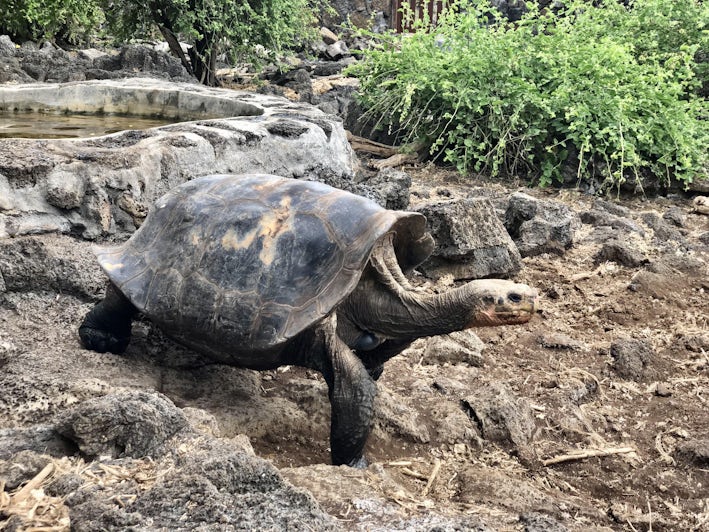
Want to See the "Big 15" Galapagos Islands Animals Up Close? This Small Cruise Ship Is Perfect for You


One of the main reasons that a Galapagos cruise tops on so many bucket lists is that many Galapagos Islands animals are found nowhere else on the planet. A small cruise ship puts those sea lions, blue-footed boobies, rare mammals, and reptiles close at hand, all within just a few days.
Our 2021 cruise to the Galapagos was aboard La Pinta, a 48-person small cruise ship owned and operated by the Ecuadorian company Metropolitan Touring. The company has been in business for 68 years, and specializes in Galapagos cruises, as well as mainland trips that you can add in Ecuador.
Metropolitan Touring has designed its Galapagos itineraries to maximize the number of "Big 15" animals and wildlife that you see on each cruise. On my five-day, four-night Galapagos cruise, visiting islands known as the "eastern Galapagos," we saw 11 of the "must see" Galapagos Islands animals -- of the so-called Big 15 -- that make this place so special.
(Other itineraries that Metropolitan Touring runs include the Northern and Western route; which islands you visit on a cruise -- as well as the season -- often dictate what animals you see. My route, for example, did not include the habitat of the cute Galapagos penguin, or the photogenic pink Galapagos flamingo).
Here are some of the Big 15 Galapagos animals and wildlife we saw on our small cruise ship, and the specific island(s) where we saw them.
Galapagos Sea Lion

Sea lions are ubiquitous within the Galapagos archipelago and are one of the main draws of most Galapagos cruises. Really, these animals are everywhere -- you'll see them on the boat docks, lying on park benches in the few towns on the islands, and frolicking, napping and fighting on every beach you go.
It's true what they say -- sea lions in the Galapagos have no fear of humans, and the often display a curiosity akin to domestic dogs or cats. You don't want to get too close -- six feet or two meters is the recommended distance -- and never touch or feed them.
Islands Where We Saw Galapagos Sea Lions: Baltra, South Plaza, Santa Fe, San Cristobal, Espanola, Santa Cruz
Galapagos Giant Tortoise

Here's the big one you came to see, literally: These reptiles are as massive as their name suggests, weighing up to 900 pounds. They are also generally older than any human on the planet, with a lifespan of up to 177 years. It's actually a miracle that the Galapagos have as many giant tortoises as they do –- the species dwindled to under 15,000 in the 1970s and there are types of giant tortoises that have gone extinct elsewhere in the world.
The conservation efforts to protect Galapagos Giant Tortoises on the islands are extensive. There are several conservation centers, including the Charles Darwin Research Station on Santa Cruz. There, you can see how the Galapagos National Park Directorate protects this endangered species, from encouraging mating efforts to incubating eggs to raising young tortoises in a predator-free environment.
However, nothing compares to the thrill of seeing one of these massive animals munching on grass in the wild along the road, as our group did on Santa Cruz. Long may they prosper.
Islands Where We Saw the Galapagos Giant Tortoise: San Cristobal (in captivity); Santa Cruz (in captivity and in the wild)
Blue-Footed Booby

You can't visit the Galapagos without hearing countless jokes about the various boobies -- T-shirt shops in particular make fun of the name, which comes from the Spanish word "boho," or clown. And indeed, these docile birds seem a bit clumsy as they walk around their rocky habitat.
The aqua-hued feet of the birds are unmistakable, and the bluer they are, the better fed the bird is (the color comes from carotenoid pigments found in the fish that they eat). Brighter-colored feet also help male blue-footed boobies in their mating rituals. In any case, the boobies do seem to show them off; these birds almost pose for photos on the rocks on some of the Galapagos islands.
Islands Where We Saw Blue-Footed Boobies: Santa Fe, San Cristobal, Espanola
Marine Iguana

You might have seen a lot of iguanas in your life, but have you seen one that swims? It's highly unlikely, as the marine iguana only lives in the Galapagos and is the only species of iguana that lives in the ocean. If you're asking yourself "What do marine iguanas eat?" as they spend all their time at sea, the answer might be surprising: red and green algae make up the marine iguana diet. Their sleek black appearance is also different from what you're used, although they do change color during mating season.
On our cruise, we came upon marine iguanas swimming or gathered in large groups, particularly to keep warm in the morning before the sun was at full strength. Just like other wildlife in the Galapagos, the marine iguanas have little fear of humans, and you can get close enough to hear them sneeze salt from their noses. We also saw them swimming in the ocean, their black bodies floating through the waves -- a sight both interesting and eerie.
Islands Where We Saw Marine Iguanas: Santa Cruz, South Plaza, Santa Fe, San Cristobal, Espanola
Red-Footed Booby

The least seen of the three booby bird species is harder to find than their more famous blue-footed counterparts. We didn't see red-footed boobies until mid-way through a hike up into the windy hills of San Cristobal, where we finally spotted a bit of crimson peeking out from the low-lying trees (other booby species nest on the ground).
Red-footed boobies only lay one egg, and one parent stands guard on it at all times, while the other goes out to hunt for fish. Once hatched and on their own, red-footed boobies can live up to 20 years.
Island Where We Saw Red-Footed Boobies: San Cristobal
Nazca Booby

These boobies may not have the colorful extremities of their red- and blue-footed brethren, but their white feathers and black "mask" give them an elegant appearance. Don’t let their good looks fool you, though -- unlike the other two species, the Nazca boobies have been known to charge people who get too close.
This aggressive behavior shows up early: Nazca boobies lay two eggs, one of which hatches first. When the second egg hatches, the older chick kills its sibling by forcing it out of the nest, often while the parent birds look on. How positively…. Darwinian.
Island Where We Saw Nazca Boobies: Espanola
Waved Albatross

The albatross carries a variety of superstitions with it, both good -- the birds were often used by sailors to help with navigation -- and bad if you kill one, as the protagonist of the Samuel Coleridge poem "The Rime of the Ancient Mariner" found out when he had to wear one around his neck.
In the wild, it's a treat to see the waved albatross in its habitat. These strong and long-lived birds are especially spectacular if you're able to catch two of them practicing their mating ceremony. As we watched, two birds came toward each other with their bills, tentatively at first, then more confidently -- and clacked them together in an odd and mesmerizing dance. Albatrosses typically mate for life, but before they find their partner, they "try out" others, using different moves to see if they are compatible. Easier than Tinder? Hard to tell.
Island Where We Saw Waved Albatross: Espanola
Galapagos Land Iguana

It's a bit tough to get too jazzed about seeing a land iguana, especially if you come from Florida or the U.S. Southwest, where the reptiles are common. But trust us, these iguanas are different -- and much rarer. Domestic animals that were brought into the Galapagos, such as dogs and cats, as well as pigs and rats, ended up almost decimating the land iguana population on certain islands. Conservation efforts are helping to restore the animals, which are crucial for helping keep different island ecosystems alive.
While not quite as mammoth as the tortoises, Galapagos land iguanas can grow up to three feet long and weigh 30 pounds. You'll find them sunning themselves during the day, often with a small finch on their back; the two are have a mutual relationship where the birds feed themselves with ticks and parasites that they remove from the lizard.
Islands Where We Saw Galapagos Land Iguanas: Santa Cruz, Baltra, South Plaza